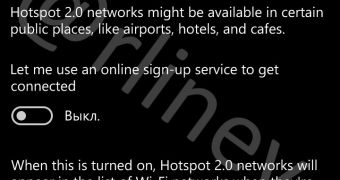The upcoming Windows 10 Anniversary Update is going to be quite an exciting update for all devices running the new operating system, including PCs and smartphones, as Microsoft’s planning to introduce several new features that will improve the experience both at the desk and on the go.
And one of these new features is Hotspot 2.0, as the company has already started testing it behind closed doors and is getting ready to release it to insiders in the coming builds.
Hotspot 2.0 is a feature that allows users to move from one hotspot to another on a specific network all automatically, without the need for authentication. Devices supporting Hotspot 2.0 will display all available wireless networks in the Wi-Fi lists, but will perform the switch all automatically.
A recent screenshot spotted by @rlinev (via MSPU) shows that Microsoft is currently testing Hotspot 2.0 on internal builds of Windows 10, and it could make it available for users in the coming builds.
While this screenshot shows it on Windows 10 Mobile, there’s no doubt that Hotspot 2.0 will arrive on the PC version too, especially given the fact that Microsoft’s trying to keep all devices in sync and offer the same features on all of them.
Microsoft first announced support for Hotspot 2.0 in 2015, so it appears that the upcoming Anniversary Update, also known as Windows enthusiasts as the Redstone update, will bring it to everyone.
How Hotspot 2.0 works
The Redmond-based tech giant has a detailed explanation of how Hotspot 2.0 will work in Windows 10 devices:
“Hotspot 2.0, also known as HS2 and Wi-Fi Certified Passpoint, is an approach to public access Wi-Fi by the Wi-Fi Alliance. The idea is for mobile devices to automatically join a Wi-Fi subscriber service whenever the user enters a Hotspot 2.0 area, in order to provide better bandwidth and services-on-demand to end-users, while also alleviating mobile carrier infrastructure of traffic overheads.”
“Hotspot 2.0 is based on the IEEE 802.11u standard, which is a set of protocols published in 2011 to enable cellular-like roaming. If the device supports 802.11u and is subscribed to a Hotspot 2.0 service it will automatically connect and roam.”
A preview build featuring this new option is expected very soon, possibly even this week, as Microsoft’s already working to update the fast ring of the Windows Insider program with a new release.

 14 DAY TRIAL //
14 DAY TRIAL //